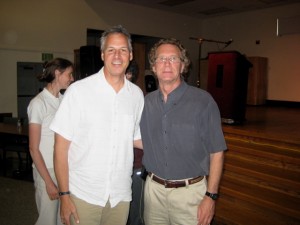
Mark C. Crowley and Dr. Rollin McCraty
“Keep the heart out of leadership” is one of the most enduring axioms in business.
Without a challenge or a doubt, most of us have accepted on face value the belief that it’s best not to connect personally with people who work for us, to demonstrate care for them in any way or to influence them with anything other than our brains and their paychecks.
Consequently, by naming my book, “Lead From The Heart,” I knew going in that my title would draw instinctive sneers from some business leaders.
But in choosing to put myself out there – and to not hide behind an ambiguous title like “A Better Way To Lead” or “A New Paradigm of Leadership for the 21st Century” – I intentionally set out to directly challenge longstanding leadership beliefs.
My conviction is that the lack of heart in leadership is killing employee satisfaction, engagement and productivity. In a truly great irony, business is failing to maximize human potential and effectiveness because it lacks the very thing it believes will cause it harm. My personal ambition is to show that what we’ve long believed to be a poison to leadership success is actually the antidote.
My own experience in leading people for nearly three decades informs my understanding of what practices truly inspire employees to bring their very best to the workplace every day. But it’s really science that is turning our ideas about the heart upside down.
As described in my book, the Institute of HeartMath has been studying the heart for twenty-five years. HeartMath’s research has shown that the heart is not only a source of great human intelligence, but what people feel in their hearts has a profound effect on their performance – both positive and negative.
A few weeks ago, I took a long drive up into the mountains east of San Diego where I live to hear HeartMath’s Director of Research, Dr. Rollin McCraty, speak at a conference. I was hoping to learn new things about the heart from Dr. McCraty and I wasn’t disappointed.
I want to share with you the key points from his speech – insights which all have truly profound implication to leadership. To be most efficient, I’ll summarize his information in bullets:
- The brain doesn’t rule the heart. While 50% of us believe the brain makes the heart beat, it actually beats all on its own. This insight makes us question any perceived superiority of the brain vs. the heart doesn’t it?
- The heart sends far more information to the brain than the brain sends to the heart. According to McCraty, “It’s not even close.”
- Emotion drives human physiology. Emotions (feelings/heart signals) determine our overall engagement in life, what motivates us and what we care about. Think about the implications of this discovery to leadership. An appeal to our employees’ brains clearly is nowhere near as effective as one to their hearts.
- A steady heart rate is actually unhealthy (and is an indicator of future health problems). What is healthy is what McCraty calls “Heart Rate Variability, (HRV)” a condition where the heart beats each minute within a steady range.
- Superior human performance is associated with a higher level of HRV. In other words, all cognitive performance (creativity, strategic thinking, in-the-moment decision making, etc.) is greatly enhanced when the heart has a high level of resting HRV.
- So what has the greatest effect on improving/increasing someone’s HRV? McCraty says it’s any form of “appreciation,” “compassion” or when people are just “feeling good.” It turns out that when people feel cared for, the heart goes into “coherence,” an orderly rhythm that facilitates our greatest brain function. Conversely, when people feel any degree of frustration or discontent, their heart rates become “edgy” and “incoherent” and brain function is significantly inhibited. How employees are made to feel then has enormous significance to workplace performance.
- When we’re in a coherent state, it makes it easier (creates an environment) for others to become coherent. HeartMath’s research proves that we all radiate an energy that others can feel. Consider, for example, the expression, “You could cut the tension in the room with a knife.” Our nervous system is able to detect that energy and it influences our reactions. Thus by demonstrating professional care for the people who work for us, we greatly and positively influence how they interact with others (think co-workers, customers, etc.). We thereby create working environments where people thrive, and consequently, organizations thrive – and isn’t that the very goal of leadership?
For 300 years, science believed the human heart had no intelligence and existed only as a blood pump. Over all that time, our common language betrayed this belief. We’ve continued to say “Learn it by heart,” “Take it to heart,”’ and “Follow your heart.” Most of us never have taken the time to ask ourselves what we mean when we say these things. If we did, we’d have to confront our longstanding belief in business that the heart somehow acts like kryptonite in leadership.
When I drove back home after hearing Dr. McCraty speak, I couldn’t wait to share his insights. But, if we’re honest with ourselves, and consider what makes humans thrive in the workplace, you’ll likely agree that I didn’t really need to make that long trip to discover the answer.
Please share any comments to this blog and feel free to share it with friends and colleagues. If you would like to receive these blogs directly, I invite you to sign up here.
PS: After this article was posted, all of the social media counters on our website mysteriously reverted to zeros — and all historical share counts were lost. All links now are working!
